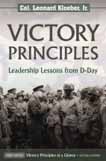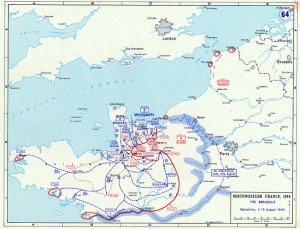Archive for the ‘Resilience’ Category
The Normandy Campaign Draws to an End
Sixty-five years ago this month, the Normandy Campaign was coming to an end after almost ninety days of brutal combat between the Allied armies and the German Wehrmacht. It began on June 6th, D-Day when British and American paratroopers jumped into the Cotiten Peninsula to secure key terrain and disrupt the Germans in advance of the assault divisions that landed on five beaches stretching for fifty miles along the coast of Northern France. Their mission was to secure a lodgement, destroy the German forces, and liberate Europe from Nazi tyranny. Although there was bitter fighting right from the start of the invasion, it only grew more intense over the next few months as they fought in the Bocage of the peninsula which was a patchwork of hedgerows. The hedgerows provided a natural defensive position from which the Germans could effectively blunt any Allied advance, and they successfully used machine guns and artillery to great advantage. Despite the Allied advantage in air power and naval gunfire , the Germans put up a stiff resistance. Their army was well trained, had combat experience, and many units, specifically the SS, were fanatical fighters who were dedicated to the Nazi regime.
Over the next few months, Allied commanders launched a series of attacks and utilized their superior air and naval forces to prepare the advance. Tragically, there were many occasions where incidents of friendly fire took place as bombs fell short of their intended targets, and Allied soldiers were killed or wounded even before the operations commenced. Yet they remained fixed on their mission, and demonstrated resilience to continue to pursue the Germans relentlessly. Resilience was crucial to the success for the Allies. It is the simple quality of an organization or individuals to overcome setbacks, and spring back so they can move ahead towards their intended objectives. Time after time, Allied soldiers and their commanders were able to overcome significant losses and rebound in spite of them.
As the weeks past, the Allies continued to bring more men and equipment into the fight while the Germans could not replace their losses. Among the German losses were some senior commanders, include Field Marshal Rommel. He was seriously injured when his staff car was attacked by an Allied fighter plane while he was traveling to visit the units at the front lines of the battle. Visiting the front at the crucial points was his custom and one of the reasons why he was one of the most effective German commanders. As the German losses mounted, their ability to counter attack was diminished. Nevertheless, Hitler demanded more aggressive action from the safety of his headquarters in East Prussia. In frustration, Hitler replaced his Commander-in-Chief, Field Marshal von Rundstedt, with Field Marshall von Kluge. When he arrived in Normandy, Kluge originally thought that the biggest problem for the Germans was a lack of leadership, but as he visited the front lines, he too quickly realized that the German army simply was not able to withstand the onslaught without more replacements and support. On July 20th, an attempt was made on Hitler’s life when a bomb was set off in his bunker in East Prussia, but he sustained only minor injuries. Although his injuries were only minor, he was ruthless in pursuing the perpetrators which included a number of regular army officers. Kluge was concerned about being implicated in the plot, so when Hitler ordered a major counter attack against the Americans from the German left flank, Kluge reluctantly carried out the order even though he knew it was the wrong strategy from purely a military standpoint. This attack at Mortain only played into the Allied plan as it was held in check while the newly activated American Third Army under General Patton broke out of the hedgerow country with his armored and mechanized formations to envelop the flank of the German Army. Within a matter of days, the German attack was completely contained, and the Americans were able to advance almost unopposed into the German rear areas.
Patton drove his troops relentlessly to continue their attack so that the Germans would not have time to recover. This was exactly the right strategy. He exploited success and when necessary even by-passed pockets of resistance to keep up the momentum. By mid-August many of the German units were depleted and beginning to break down under the stress of constant combat. After encircling most of the German Army, the Americans and British attempted to complete the encirclement at Falaise. The Canadians and Poles were attacking from the north towards Falaise while Patton’s Americans and the French 2nd Armored Division were attacking north intending to meet up with them. After reaching Argentan, Patton was ordered to stop his advance to avoid a friendly fire incident with the Canadians and Poles; however, the Canadians and Poles had run into determined resistance from SS Panzer units that were trying to keep the Gap open so that others could escape east across the Seine River to fight another day. In this, they were successful for awhile, but eventually the gap was closed and the Allied air forces relentlessly attacked any Germans on the road moving east. By the end of August, the remaining Germans who were not killed inside the “Falise Pocket” surrendered to the Allies. Knowing that he would be blamed for the defeat, Kluge took his life with a cyinad pill. Meanwhile, the German commander in Paris defied Hitler’s orders to destroy the city and defend it to the last man. He declared it an “open city” and so it was fortunately spared the fate of many of the smaller villages and cites in Normandy that were ruined during the preceding weeks of brutal combat. The Free French Forces under the command of General LeClerc were given the honor to be the first Allied troops to enter Paris.
With the liberation of Paris, the Normandy campaign was officially over, but price in terms of casualties and destruction of property had been great. Not just for the armies, but also for the many French civilians who were killed, wounded, or displaced from their homes that were destroyed. Almost 20,000 were killed and many more wounded. Cities like Caen and St. Lo were reduced to a pile of rubble. Many other towns were partially runied as the Germans and the Allies traded artillery barges, or when Allied bombers dropped their payloads in advance of the attack. In the process of liberating the Continent, much of it was destroyed. It is significant the the Free French Forces joined the Allied effort with the full knowledge that their country would suffer so much in the process. Following the Normandy Campaign, there would still be months of bitter fighting all through the winter of 1944-45. The Allied Supreme Commander, General Eisenhower, would be challenged not only by the Germans, but also by the infighting among the Allied commanders. However, he successfully led the coalition to complete his mission that he started on June 6th when the Germans finally surrendered unconditionally in May 1945. So, as Prime Minister Churchill aptly stated, although Normandy was not the end, perhaps it was the beginning of the end.

